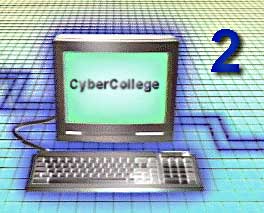The Internet |
|
The Internet Part II
From the relatively speedy computer devices we've discussed so far we now turn to the first real bottleneck in the Internet speed process--the modem. A modem, an acronym that stands for modulation-demodulation, changes digital computer information into sounds that can be sent (modulated) and received (demodulated) via Since telephone lines were never meant to transmit digital data, the process of changing digital data into sounds that can be sent back and forth over telephone lines leaves much to be desired. Nevertheless, we already have our homes wired for telephones, and the cost of rewiring them all for digital data would be prohibitive. Things may change in the future if the high-speed fiber optic lines that now connect the major telephone systems eventually find their way into our homes. The first modems were introduced in the 1950s. They operated at less than 100bps (bits of data per second). By today's standards this is dreadfully slow, but at that time it was fast enough for such things as text-based airline reservations and AP news wires. In those days the Internet didn't display complex pages with images, only lines of text on black-and-white computer screens.
Clicking a mouse button on one of these points (coordinates) could initiate an action. After these developments fell into place, not only did computers become much more user friendly, but also the foundation for hyperlinks and browsers (such as the program you are using to view this page) was established. It was also at this point that the famous "www" or Worldwide Web became a major category for addresses on the Internet. A GUI requires thousands of times more digital data than the simple lines of text that had previously been a part of the Internet. So further R&D (research and development) on modems took place, resulting in step-by-step speed increases to 600, 1,200, 2,400, and then 2,800bps. But when color photos and complex pages became commonplace, even these speeds were too slow. Pornographic pictures were a major force behind the growth of Worldwide Web and the push for faster modems. A few decades before, pornographic videos were the driving force behind the development of videotape rentals. As uncomfortable as many people are with these facts, it's easy to substantiate them by simply "following the money" and looking for the primary driving force behind these video and Worldwide Web developments. By this time various compression techniques were being used to condense digital data, and thus, effectively speed up data flow through a modem. By the late 1990s modem speeds had jumped to what seemed to be the limit of what telephone lines and compression techniques could handle: 54,000bps, or "53Kbps"("k" standing for "thousand.") But, as manufacturers are required to point out, "54K modems" are only capable of about 52K in the best of situations, due primarily to voltage limitations on standard telephone lines. Since analog data sent in the form of audio over telephone lines degrades with distance, the actual speed of your modem depends on how close you are to the nearest telephone switching station. If you are less than a mile away, or the switching equipment is in your office building, things can go fairly well. If you are at home, miles away from a switching station, modem speeds will be significantly lower than 52Kbps. Although 100Kbps (100,000bps) modems using standard telephone lines are on the drawing board, we may find that they are eclipsed by approaches that are much faster: notably DSL, ISDN, and satellite links. We'll talk about each of these a little later. If you are reading this in a school computer lab, the chances are that your school is wired to the Internet with a T1 line. Most libraries now have high-speed T1 lines. Telephone lines are still used in this case, but they are configured for digital data rather than audio-based analog data. T1 lines are capable of transmitting digital data at more than 1.5 megabits (billions of bits) per second--thousands of times faster than the standard analog-based dial-up modem of your home computer. There are also T3 lines that can transmit data more than three times faster than T1 lines, but at this point they are not widely used in institutional settings.
When you click on a computer hyperlink you may be taken to a computer site thousands of miles away. This means that the signal may have to be routed through hundreds of relay points and telephone amplifiers. Since we are dealing with a series of tones coming from and being sent to your computer, telephone line noise, static, or distortion can obliterate the message. If it weren't for error correction your computer screen could regularly fill up with meaningless "garbage characters." To try to stop this from happening the data is sent and received in blocks of information. Before a block is sent it's mathematically analyzed and a checksum (a calculated value reflecting the nature of the original data) is figured and transmitted along with the data block. If the checksum on the receiving end doesn't match the checksum of the original data block, an error in the transmission is signaled. Then before the next block of data is sent, the receiving modem requests that the data block be resent. Having to retransmit blocks of data obviously slows down transmissions. Errors tend to be more prevalent at high modem speeds. If the modem detects too many errors during a certain period of time, it's programmed to automatically lower its speed to a point where accuracy increases. Although you may have a 54K modem, when it initially connects with your ISP (Internet service provider, such as Earthlink, or AOL), it may determine that a lower speed--45K, 33K, or 28K--is necessary for reliable transmissions. Thus, your connection speed is often lower than the top speed of your modem. You might assume that the blocks of data are all sent over the Internet using the shortest route between computers. That's not necessarily the case. In fact, depending in Internet conditions at that given second, the blocks of data might each take very different geographic routes getting to a common destination. This is actually one of the strengths of the Internet. If problems develop at one or more relay points, traffic is automatically rerouted. As we will see in the next module, this feature was a cornerstone in the original Internet design. Each block of data that is sent over the Internet carries an "address." (There will be more on this in Internet Module 4.) Once the individual data blocks arrive at their destination, they are combined in the intended sequence. This process can be likened to using dozens of post cards to send a term paper from one person to another. Each post card can only contain one or two sentences. Let's assume you address each post card to the same person and then drop them all in a mailbox. They may go different routes; some might even go by trucks and some by aircraft. Once they arrive at the common destination, they have to be put in the proper sequence. This analogy shows you a bit of the complexity of how data is sent over the Internet.
If the Internet had been designed from the beginning to accommodate millions of simultaneous users, these problems might have been avoided. However, the original design didn't envision a fraction of the traffic we now see. Ever since the Internet "took off," equipment and facilities have been trying to play "catch up"--and never quite catching up.
And, when it comes to the issue of Internet speed, it certainly doesn't help that there are millions of spam messages (unsolicited and unwanted advertising messages). In 2004 it was estimated that nearly 80% of e-mail was spam. . Fortunately, there are computer programs that are successful to varying degrees in eliminating spam from your mailbox.
In the next section we'll look at some more of the key elements in the Internet. |
|
To next module To
index © 1996 - 2005, All Rights Reserved.
|

 telephone lines. Most modems, such as the one shown on the left, plug into a slot inside the computer. Modems that are external to the computer are also available to meet special needs.
telephone lines. Most modems, such as the one shown on the left, plug into a slot inside the computer. Modems that are external to the computer are also available to meet special needs.
 Then something called GUI (graphical user interface, pronounced goo-ey) was devised. This made it possible to display interactive images on computer screens. Through a system of X-Y screen coordinates coupled with a mouse or pointing device, the computer could be made "aware" of where a mouse was pointing.
Then something called GUI (graphical user interface, pronounced goo-ey) was devised. This made it possible to display interactive images on computer screens. Through a system of X-Y screen coordinates coupled with a mouse or pointing device, the computer could be made "aware" of where a mouse was pointing. Of course the biggest "speed limit" is the Internet itself. The Worldwide Web is often referred to as the "worldwide wait," because it sometimes slows down to a crawl, or even freezes, during high use periods.
Of course the biggest "speed limit" is the Internet itself. The Worldwide Web is often referred to as the "worldwide wait," because it sometimes slows down to a crawl, or even freezes, during high use periods. Most young people average several hours a week on the Internet-- especially since almost 100% of U.S. schools have Internet connections. A 2001 survey found that teens divide their Internet time into roughly six categories, as shown here.
Most young people average several hours a week on the Internet-- especially since almost 100% of U.S. schools have Internet connections. A 2001 survey found that teens divide their Internet time into roughly six categories, as shown here.